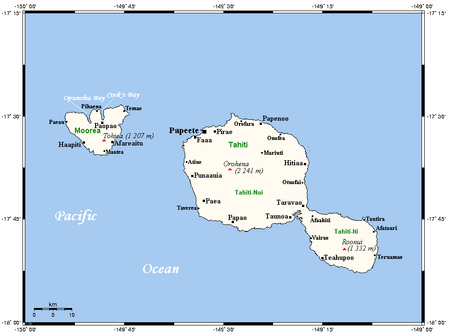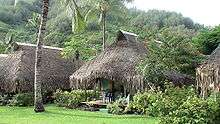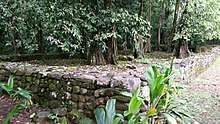Mo'orea
Mo'orea (English: /ˌmoʊ.oʊˈreɪ.ɑː/ or /ˈmoʊ.oʊreɪ/;[4] Tahitian: /moʔore(ʔ)a/), also spelled Moorea, is a high island in French Polynesia, one of the Windward Islands, part of the Society Islands, 17 kilometres (11 mi) northwest of Tahiti. The name comes from the Tahitian Mo'ore'a, meaning "yellow lizard": Mo'o = lizard ; Re'a (from re'are'a) = yellow.[5] An older name for the island is 'Aimeho, sometimes spelled 'Aimeo or 'Eimeo (among other spellings given by early visitors before Tahitian spelling was standardized). Early Western colonists and voyagers also referred to Mo'orea as York Island.
.jpg) View of Mo'orea | |
| Geography | |
|---|---|
| Location | Pacific Ocean |
| Coordinates | 17°32′S 149°50′W |
| Archipelago | Society Islands |
| Area | 134 km2 (52 sq mi) |
| Highest elevation | 1,207 m (3,960 ft) |
| Highest point | Mont Tohive'a[1] |
| Administration | |
France | |
| Overseas collectivity | French Polynesia |
| Administrative subdivision | Windward Islands |
| Commune | Mo'orea-Mai'ao |
| Capital city | 'Āfareaitu |
| Largest settlement | Pao Pao–Maharepa (4,244 inhabitants) |
| Demographics | |
| Population | 16,191[2] (Aug. 2007 census) |
| Pop. density | 121/km2 (313/sq mi) |
| Official name | Lagon de Moorea |
| Designated | 15 September 2008 |
| Reference no. | 1834[3] |
Transportation
Several ferries go to the Vai'are wharf in Mo'orea daily from Pape'ete, the Tahitian capital. The Vai'are wharf is in the Vai'are bay. There are 3 ferries. One of them is the 'Aremiti 5. The largest one is the 'Aremiti Ferry and the other one is the Terevau ferry. The ferries have to pass through Mo'orea's coral pass, then toward Pape'ete across the ocean and into the Tahiti Lagoon. The Vai'are bay is in the east part of Mo'orea. Mo'orea's Tema'e Airport (IATA: MOZ) has connections to the international airport in Pape'ete and onward to other Society Islands such as Bora Bora. If the islanders want to make an international flight, they would take Air Tahiti to get to the Fa'a'ā International Airport on Tahiti. The Mo'orea airport is located north of the Vai'are bay. There is one road that goes around the island. Along the road are kilometre markers from 1 to 35. The first one is near the airport. The 35th one is in Ha'apiti.
Geography

The island was formed as a volcano 1.5 to 2.5 million years ago, the result of a Society hotspot in the mantle under the oceanic plate that formed the whole of the Society Archipelago.[1] It is theorized that the current bays were formerly river basins that filled during the Holocene searise.
Mo'orea is about 10 miles in width from the west to the east. There are two small, nearly symmetrical bays on the north shore. The one to the west is called 'Ōpūnohu Bay, which is not very populated but many travelers have come into the bay. The main surrounding communes of the bay are Piha'ena in the east and Papetō'ai to the west. The one to the east is Cook's Bay, also called Pao Pao Bay since the largest commune of Mo'orea is at the bottom of the bay. The other communes are Piha'ena to the west and busy Maharepa to the east. The highest point is Mount Tohi'e'a, near the center of Mo'orea. It dominates the vista from the two bays and can be seen from Tahiti. There are also hiking trails in the mountains. The Vai'are Bay is another small inlet, smaller than the two main bays, on the east shore. This bay has been settled a lot and has a lot of business. The main village is located just south of the bay.
Politics
The island is administratively part of the commune (municipality) of Mo'orea-Mai'ao, itself in the administrative subdivision of the Windward Islands. The main village is 'Āfareaitu.[6] The largest village is Pao Pao at the bottom of Cook's Bay. The second largest is Maharepa.
Tourism

Because of its stunning scenery and accessibility to Pape'ete, Mo'orea is visited by many western tourists who travel to French Polynesia. Especially popular as a honeymoon destination, Mo'orea can often be seen in advertisements in American wedding magazines. Arthur Frommer declared in Frommer's travel guide that he considered it the most beautiful island in the world.[7]
History

Like many of the other islands, Mo'orea was first settled by Polynesians from the islands west of Mo'orea. They arrived on canoes coming down from South Asia looking for islands to settle. It is estimated that they arrived on Mo'orea roughly 1000 years ago. There are some ancient landmarks on Mo'orea known as marae, which consists of ancient stone rocks shaped like pyramids. On the rocks are carvings that tell when sacrifices occasionally took place. The oldest marae is the 'Āfareaitu Marae, located in the island's main village. It was made by the early Polynesians in the year 900.
The first European that recorded its sight was Pedro Fernandes de Queirós in 1606.[8] The first settlers who were Europeans arrived during the 18th century. The first European to arrive on the island were the Englishmen Samuel Wallis and James Cook. Captain James Cook first landed on Tahiti, where he planned the 1769 Transit of Venus observed from Tahiti and Mo'orea. At Mo'orea, where Ta'aroa was chief, Cook first landed in 'Ōpūnohu Bay, Cook's Bay was later named in his honor. Spanish sailor Domingo de Bonechea visited it in 1774 and named it Santo Domingo.[9][10]
The island was among those visited by the United States Exploring Expedition on its tour of the South Pacific in 1839.[11]
Charles Darwin found inspiration for his theory regarding the formation of coral atolls when looking down upon Mo'orea while standing on a peak on Tahiti. He described it as a "picture in a frame", referring to the barrier reef encircling the island.[12]
Don the Beachcomber lived here briefly in the late 1920s. His houseboat was destroyed by tropical cyclones after he moved it from Waikiki after 1947.[12]
On October 7, 1967, construction was completed on the Mo'orea Airport, which opened the following month.[13]
Research facilities
The University of California, Berkeley maintains the Richard B. Gump South Pacific Research Station[14] on the west coast of Cook's Bay. The Gump station is also home to the Mo'orea Coral Reef Long Term Ecological Research Site (MCR LTER). The project, funded by the US National Science Foundation (NSF), is a partnership between the University of California Santa Barbara and California State University, Northridge that includes additional researchers from UC Davis, UC Santa Cruz, UC San Diego, Duke, and the University of Hawaiʻi. The Mo'orea Coral Reef LTER is part of the National Science Foundation's Long Term Ecological Research (LTER) Network. The LTER Program was established by the NSF in 1980 to support research on long-term ecological phenomena. The Mo'orea Coral Reef LTER became the 26th site in the LTER network in September 2004.
The French EPHE (École pratique des hautes études) and now the CNRS (National Centre for Scientific Research) maintain a research station at the end of 'Ōpūnohu Bay since about 1970. This Centre de Recherches Insulaires et Observatoire de l'Environnement (Centre for island research and environment observatory) or CRIOBE is a research site for several international projects, including the monitoring of coral reefs throughout French Polynesia as well as the monitoring of the fish population on the Tīahurā transect of Mo'orea's reef for over 30 years.
The tree Phyllanthus nadeaudii is endemic to Mo'orea, meaning it is found nowhere else on earth.
Popular culture
In the film Love Affair, a scene where Warren Beatty's character visits his aunt takes place on Mo'orea.
Jimmy Buffett has stated that Mo'orea is the inspiration for his song One Particular Harbor
References
- Scheffel, Richard L.; Wernet, Susan J., eds. (1980). Natural Wonders of the World. United States of America: Reader's Digest Association, Inc. p. 257. ISBN 0-89577-087-3.
- Institut Statistique de Polynésie Française (ISPF). "TABLEAU II Population des communes et communes associées de Polynésie française" (PDF) (in French). Archived from the original (PDF) on 2008-02-29. Retrieved 2007-12-02.
- "Lagon de Moorea". Ramsar Sites Information Service. Retrieved 25 April 2018.
- "Mooréa". Merriam-Webster Dictionary. March 13, 2017.
- Sven Wahlroos (2002). English–Tahitian, Tahitian–English Dictionary (First ed.). Honolulu: The Mā'ohi Heritage Press. p. 312, 545. ISBN 0-9627095-7-3.
- Archived March 2, 2007, at the Wayback Machine
- "Frommer's The Most Beautiful Islands". 2010-03-02. Retrieved 2010-03-02.
- Rienzi, M.L. Historia de la Oceanía, o quinta parte del mundo Barcelona, 1845-1846, vII, p.267
- Boenechea, Domingo de Descripción de las islas del Océano Pacífico reconocidas últimamente de ordne de S.M., por Don Domingo de Boenechea, capitan de fragata de la Real Armada, y comandante de la de S.M. nombrada Sta. María Magdalana (alias el Aguila), en los años de 1772 y 1774 Manuscript 476 of the Museo Naval de Madrid, fo. 94
- Salmond, Anne (2010). Aphrodite's Island. Berkeley: University of California Press. pp. 38, 173. ISBN 9780520261143.
- Stanton, William (1975). The Great United States Exploring Expedition. Berkeley: University of California Press. pp. 130. ISBN 0520025571.
- "Moorea "The Majestic Island"". Fly Tahiti. Retrieved 25 July 2014.
- La SETIL Aéroports exploitant des aéroports: Tahiit Faa'a, Bora Bora, Raiatea, Rangiroa, Huahine, Moorea
- Richard B. Gump South Pacific Research Station
External links
![]()
![]()
- Official site (Tahiti Tourisme Board)
- Mo'orea Visitors Bureau
- Mo'orea Travel Information
- Directory: direct links about Mo'orea
- Photogallery of Mo'orea
- Mo'orea Coral Reef Long Term Ecological Research Site
- U.C. Berkelely Richard B. Gump South Pacific Research Station
- "Surgical Strike: Mo'orea Surf Mission" Photos And Video
- The Island of Mo'orea at the Smithsonian Ocean Portal
